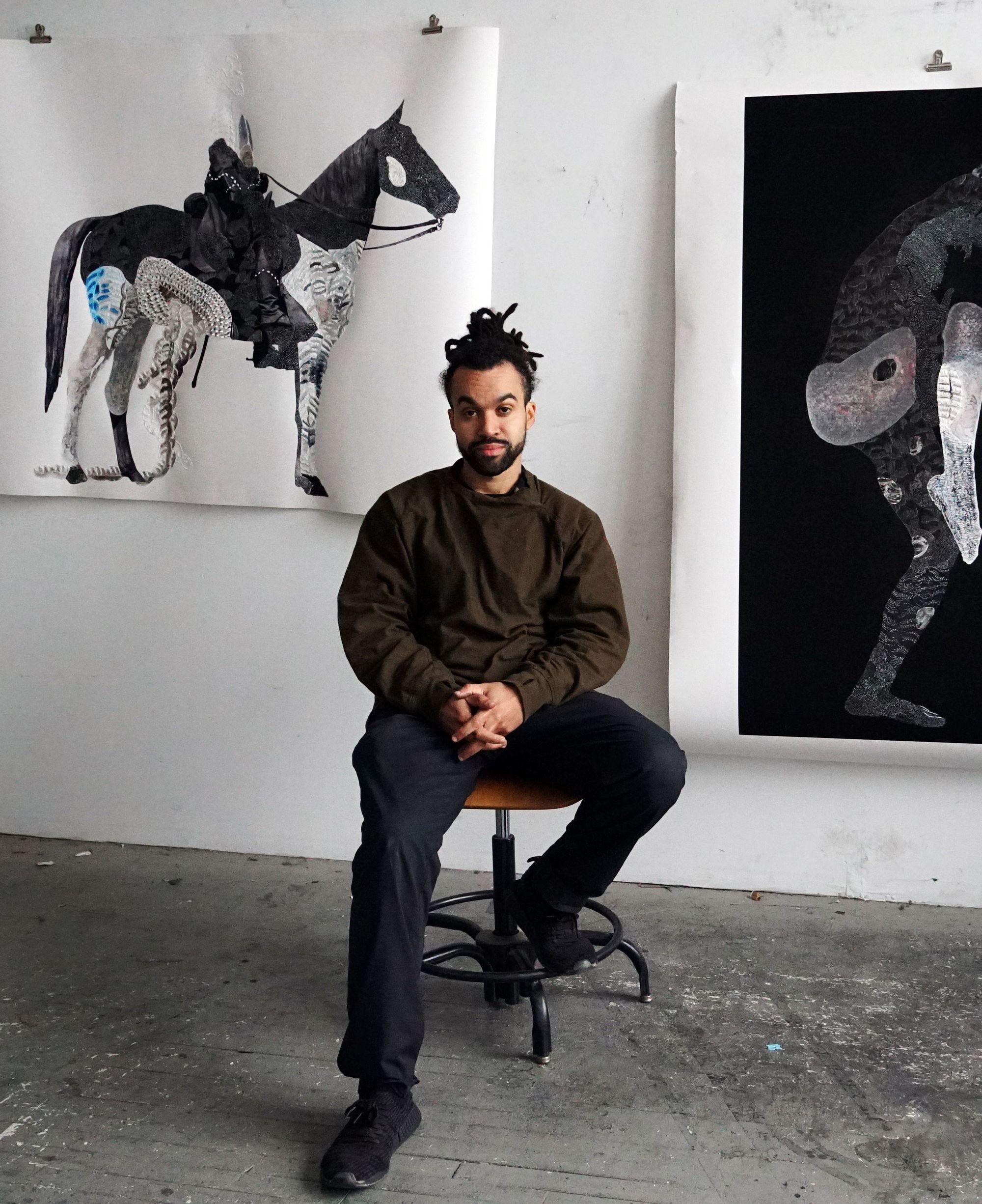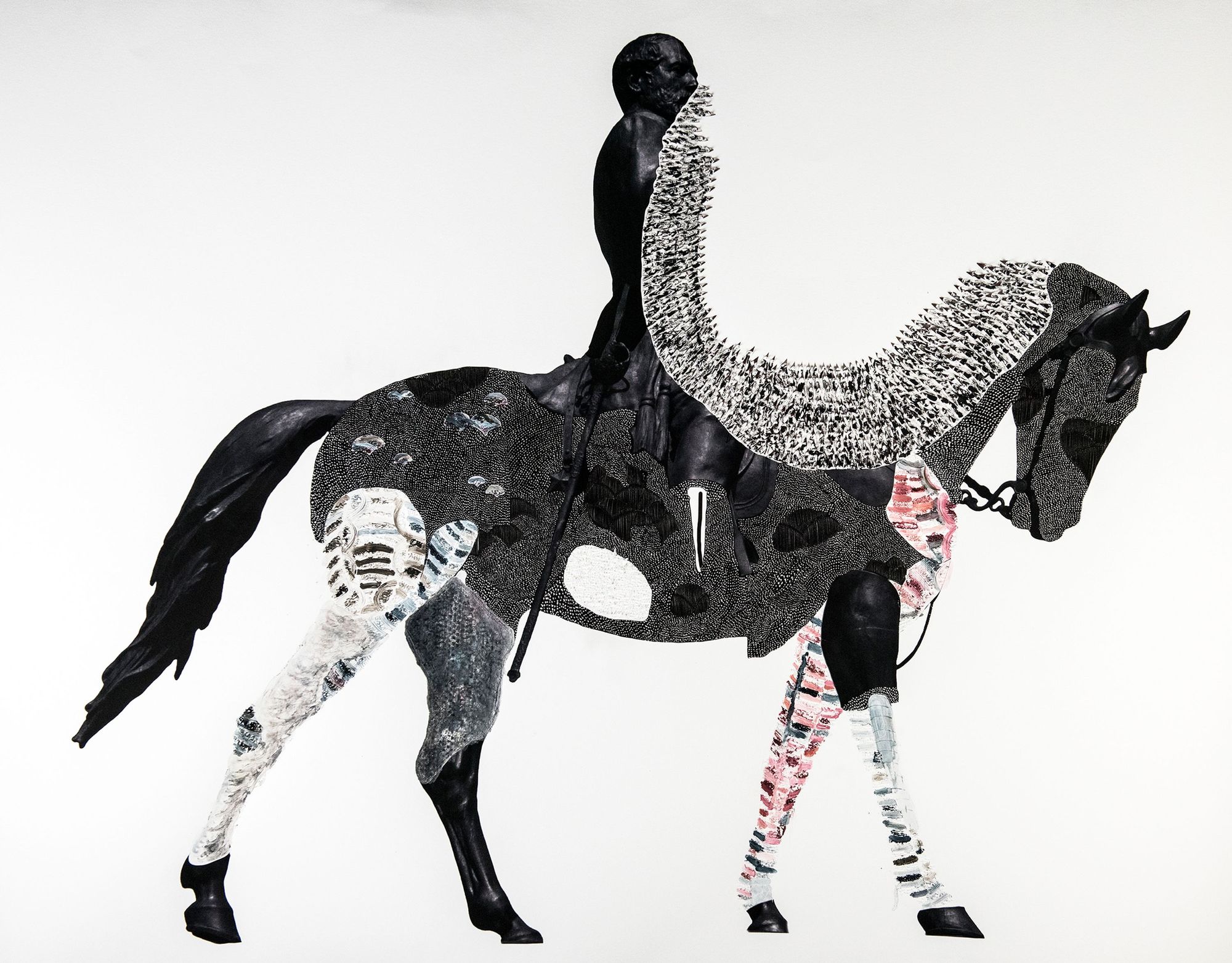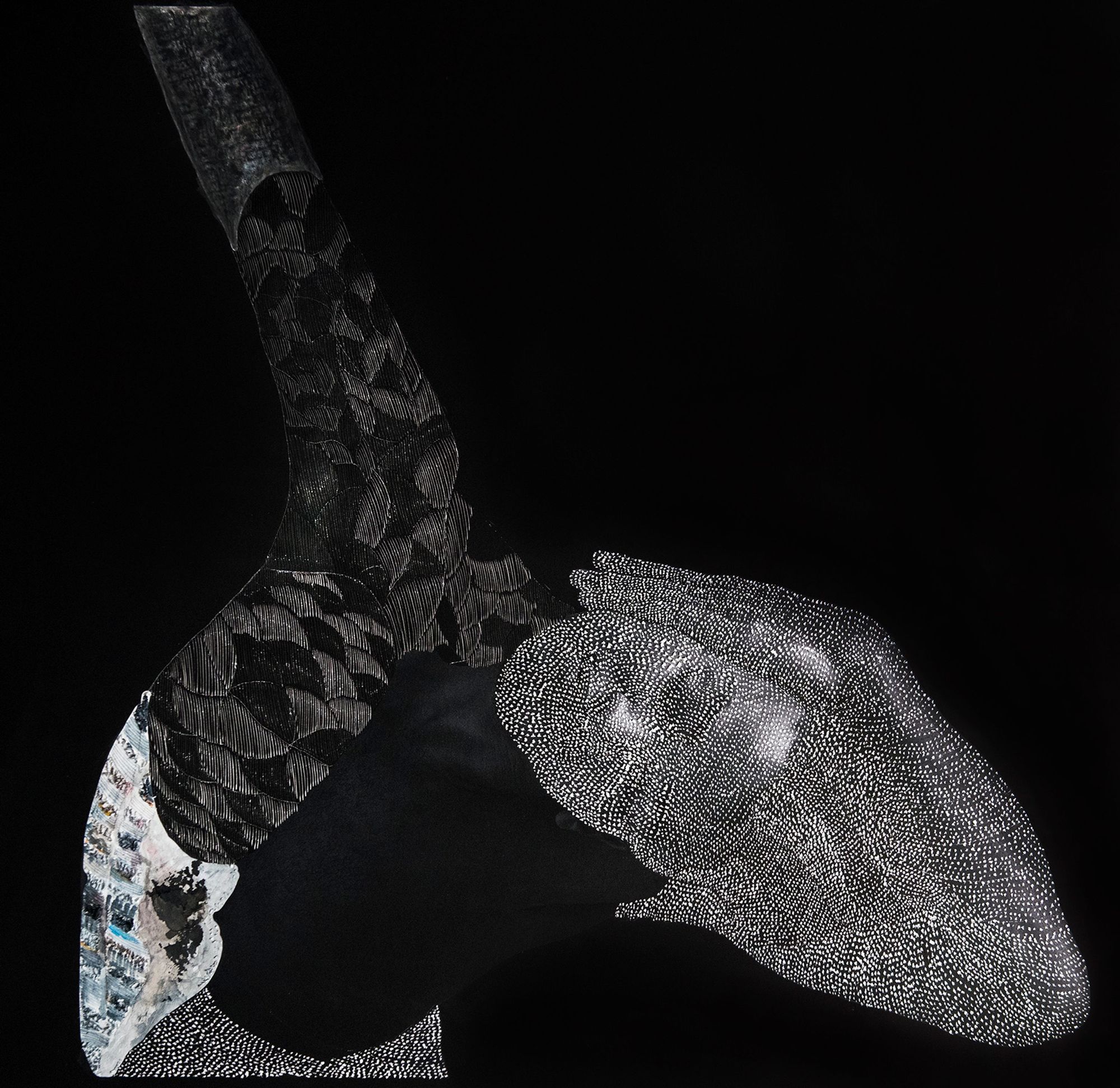On Pause with Nate Lewis
Nate Lewis punctures and incises paper with X-Acto knives, to define—both texturally and symbolically—the characters who inhabit the surfaces of his work. While these actions can denote violence, the 35-year-old artist executes them with a profound sense of care and compassion that traces back to a former life as an intensive care nurse. His sculptural cuts, coupled with graphite and ink markings, draw from a deep well of empathy in order to humanize subjects that have been abstracted and made monochromatic. Fusing organic rhythm with surgical precision, Lewis draws attention to the cellular compositions of our bodily makeup, as though to expose the biological vulnerabilities inherent to human beings’ social selves.
In spite of the fact that he did not take up a serious interest in artmaking until he was well into his early adulthood, Lewis appears naturally attuned to the delicate nuances of his chosen materials and subject matters. There is a subtle yet apparent evolution taking place within the artist’s budding practice. Whereas earlier works hone in on the physiology of isolated characters, his more recent creations venture onto grander themes that pertain to race, history and politics. A clear passion for music is also becoming pronounced within Lewis’s practice; his new exhibition Latent Tapestries at Fridman Gallery, for instance, pairs works on papers with a soundtrack of avant-garde jazz compositions.
Against the current context of a global pandemic, the former Pioneer Works Resident speaks to his dual entries into art and medicine, as well as his experience and interests during this time.

A lot of the existing literature about your work has centered on your past experience as a critical care nurse, so I want to ask you to go back even further in your history. When did you first become interested in art?
There isn't too much further to go back to. While I was in my last year of nursing school in 2008, I started to play the violin. That was my first engagement in creating something—at that time, sound. The first time I started to draw in my life was two years into my career as an ICU nurse, which was in 2010. But I would say that my understanding of art, aesthetic and design came first through fashion, particularly shoes. I was a ‘sneaker head’, and I was at the front of the curve when it came to customizing shoes. First, I bought Gucci fabric off of eBay, and took that to a shoe repair shop to have my shoes customized to my specifications. Then, I bought Burberry fabric and had them do the same to some butter Timberlands. I started seeing similar ideas in sneaker message boards. I was into it; it was fresh.
I didn’t make art back then, but my sister Leah has been an artist since day one. I talked to her about it, and she loved the idea of painting my shoes. So, I bought a pair of all white Nike Air Force sneakers, and told her my vision. It was Egyptian-themed—hieroglyphics and Egyptian gods. They were turquoise, white, and brownish yellow, almost like a worn papyrus color. She nailed them. I was over the moon when they were done.
What compelled you to work in a hospital, before all of these interests took shape? How has that experience shaped your practice?
The earliest memories regarding my interest in science and biology was in first grade, I think. Learning about red blood cells, white blood cells, and platelets captivated me immediately; it also made sense to me. Early on, my mind understood a scientific way of thinking. Also, my father worked as a nurse anesthetist, so he would tell me about his days at work—particularly cases, and what his role was in them. By the time I was in fifth grade, I decided that I wanted to be a nurse anesthetist. I followed through in that I worked as an ICU nurse, which is a requirement before applying to nurse anesthesia school. Then I decided to pursue art, so I never applied.
While there are many things from my experience that have shaped my work, I'll name one that I feel is an anchor within my practice. The first thing we do as healthcare workers, when presented with a patient situation, is to do an incredibly thorough assessment. This is done while bearing the normal parameters in mind. That can vary sometimes, depending on the patient that we are taking care of—their anatomy, past medical history and, sometimes, things we just can't explain. The assessment is done to see where, if, and why there is an imbalance in the patient's condition; and what needs to be done in order to achieve that balance. I think that this practice has taught me how to approach materials and content with an elastic way of thinking and investigating.

You opened your first New York solo exhibition, at Fridman Gallery, only two weeks before all non-essential businesses were ordered to close to the public. So many other artists are experiencing similar situations right now, but we aren’t hearing from them very much—at least not enough, and not publicly. Can you share what this experience has been like for you, as an artist?
It's interesting. I've been patient in having my first New York solo exhibition. Iliya Fridman was open to giving me a solo show very early on in our relationship, but I kept pushing it back. I had an idea about the kind of artist that I wanted to be, but wasn't quite sure how to be that artist yet. I wanted my first New York solo to set a tone for that, so I gave myself time to develop a deeper understanding of my work. What are the specific threads that tie my thinking together, and where did those come from?
I was pleased with what I came up with for Fridman Gallery. I put on the show that I wanted; it was received well, sold out, and then it all came to a close because of the virus. I wanted more people to see the exhibition and to have continued dialogue around it, but it was divine timing that it opened before everything went on lockdown. I'm at peace regarding it all. It is teaching me to continue to be patient, and to keep making the work that I want to make.

Can you share what you have been reading, listening to, and watching during this quarantine period?
A novel titled Lucy by a Caribbean author named Jamaica Kincaid. Also, Paul Virilio’s War and Cinema: The Logistics of Perception, and Tony Morrison’s Song of Solomon. I am listening to Cenizas by Nicolas Jaar; Brooklyn Rider's new album, which features string compositions composed by many different incredible composers including Matana Roberts and Caroline Shaw; I THINK I’M GOOD by Kassa Overall; Who Sent You? by Irreversible Entanglements; A Written Testimony by Jay Electronica; Ben LaMar Gay; Moses Sumney; Jon Bap; Chassol; FKA Twigs.
I've been tuning into a lot of friends’ Instagram live sessions, and it has been great to learn more about their practices and lives. Also, I’ve been tuning into Swizz Beatz and Timbaland’s VERZUS series on Instagram, which is such a cool pivot in the time of quarantine. Just starting to watch Tiger King, because life. But I’m not watching anything else at the moment, as I try to limit my television and movie time.
Apart from that, how are you keeping busy and maintaining focus?
I came down to DC last week to be closer to my family; I figured I might as well kick it with them during a time when we all have to be inside. I'm at a friend’s now, for an in-between 14-day quarantine period. Over the past two weeks, I've been starting to learn Ableton music and sound software—doing online tutorials to start learning the interface and functions. This is what I’m going to be focusing on.
I've also been training, and working out a lot in a nearby park. Movement and martial arts are a big part of my life, and physicality is an important part of how I process information. So, it has been peaceful to really spend time outside, engaging with movement as a discipline and also as play, like I did in my pre-college years. It taps into my memory, and allows me to process information through a different filter.
I decided to not stick to any schedule for the first two weeks of my quarantine, to give myself that pause. After that, I’m going to be more deliberate in how I go about my day—be less wavy with it, but still maintain some waviness. I’m a very disciplined person, so I’m not worried about maintaining focus. I’m looking forward to creating without a hard deadline, and letting things blossom.
Subscribe to Broadcast